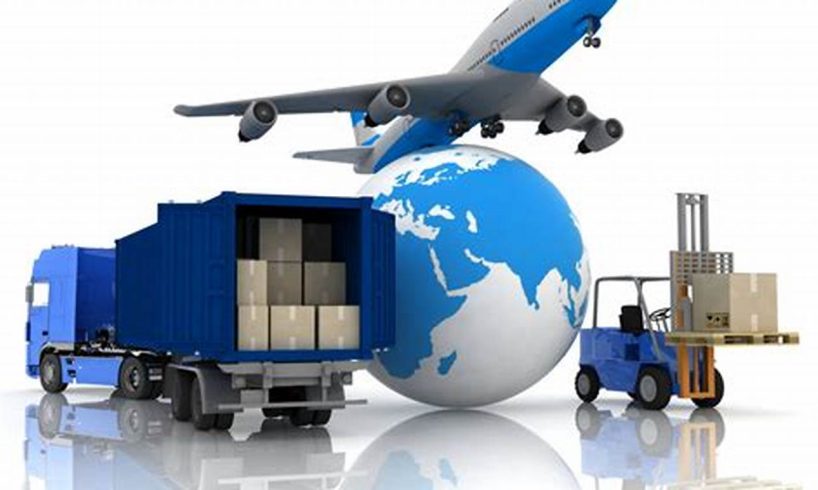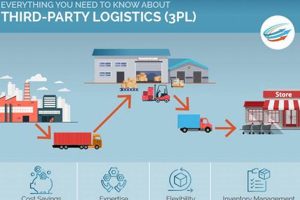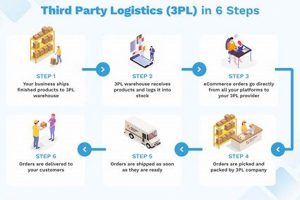
Distribution and logistics services are the backbone of the modern global economy, enabling businesses to get their products from the point of production to the end consumer efficiently and cost-effectively. These services encompass a wide range of activities, including warehousing, transportation, inventory management, order fulfillment, and customer service.
The importance of distribution and logistics services cannot be overstated. Businesses that have efficient and reliable distribution networks can gain a significant competitive advantage by getting their products to market faster, reducing costs, and improving customer satisfaction. In today’s fast-paced, globalized world, consumers expect to be able to get the products they want, when they want them, and where they want them. Distribution and logistics services make this possible.
The history of distribution and logistics services can be traced back to the early days of commerce. As businesses began to trade goods over long distances, they needed to find ways to transport and store their products safely and efficiently. Over time, a complex network of distribution and logistics services evolved to meet the needs of businesses and consumers.
1. Transportation
Transportation is the physical movement of goods from one location to another. It is a critical component of distribution and logistics services, as it enables businesses to get their products to market and to customers. There are many different modes of transportation, including road, rail, air, and water. Each mode has its own advantages and disadvantages, and the best choice for a particular shipment will depend on factors such as cost, speed, and reliability.
- Road transportation is the most common mode of transportation for short-haul shipments. It is relatively inexpensive and flexible, and it can be used to reach a wide range of destinations. However, road transportation can be slow, and it can be subject to delays due to traffic congestion and weather conditions.
- Rail transportation is a good option for long-haul shipments. It is more efficient than road transportation, and it can be used to transport large volumes of goods. However, rail transportation is not as flexible as road transportation, and it can be more expensive.
- Air transportation is the fastest mode of transportation. It is ideal for shipments that need to be delivered quickly, such as perishable goods or high-value items. However, air transportation is the most expensive mode of transportation, and it is not always available for all destinations.
- Water transportation is the most cost-effective mode of transportation for large, bulky shipments. It is often used to transport raw materials and other commodities. However, water transportation is slow, and it can be subject to delays due to weather conditions and port congestion.
The choice of transportation mode is a critical decision for businesses. The right mode can help businesses to reduce costs, improve efficiency, and meet customer demand.
2. Warehousing
Warehousing is a critical component of distribution and logistics services. It involves the storage of goods until they are needed by customers. Warehouses can be located at various points in the supply chain, such as near production facilities, transportation hubs, or major population centers. The purpose of warehousing is to ensure that goods are available when and where they are needed, and to protect them from damage or theft.
There are many different types of warehouses, each with its own unique purpose. Some warehouses are designed to store large volumes of goods, while others are designed to store specialized items. Warehouses can also be temperature-controlled to protect goods from spoilage. The type of warehouse that a business uses will depend on the nature of its products and its distribution needs.
Warehousing is an essential part of the distribution and logistics process. It helps businesses to manage their inventory, reduce costs, and improve customer service. By storing goods in warehouses, businesses can ensure that they have the products they need to meet customer demand, when and where they need them.
3. Inventory Management
Inventory management is a critical component of distribution and logistics services. It involves the planning, control, and optimization of inventory levels to ensure that businesses have the right amount of stock on hand to meet customer demand. Effective inventory management can help businesses to reduce costs, improve efficiency, and increase customer satisfaction.
- Facet 1: Maintaining Optimal Stock Levels
Inventory management involves maintaining optimal stock levels to meet customer demand without overstocking or understocking. Overstocking can lead to increased storage costs, obsolescence, and waste, while understocking can result in lost sales and customer dissatisfaction. Effective inventory management techniques, such as just-in-time inventory and safety stock, can help businesses to find the right balance. - Facet 2: Forecasting Demand
Accurate demand forecasting is essential for effective inventory management. Businesses need to be able to predict future demand for their products in order to ensure that they have the right amount of stock on hand. There are a variety of demand forecasting techniques that businesses can use, such as historical data analysis, market research, and trend analysis. - Facet 3: Managing Inventory Costs
Inventory management involves managing a variety of costs, including storage costs, handling costs, and obsolescence costs. Effective inventory management can help businesses to reduce these costs by optimizing stock levels and minimizing waste. - Facet 4: Using Technology
Technology can play a major role in inventory management. Inventory management software can help businesses to track stock levels, forecast demand, and manage costs. Technology can also be used to automate inventory processes, such as order fulfillment and shipping.
Effective inventory management is essential for efficient distribution and logistics services. By optimizing inventory levels, forecasting demand, managing costs, and using technology, businesses can improve their bottom line and increase customer satisfaction.
4. Order Fulfillment
Order fulfillment is a critical component of distribution and logistics services. It encompasses the processes involved in receiving, processing, and delivering customer orders. Efficient and accurate order fulfillment is essential for businesses to meet customer expectations and build lasting relationships.
- Facet 1: Order Processing
Order processing involves receiving and validating customer orders. This includes checking inventory availability, verifying payment information, and generating shipping documentation. Accurate order processing is essential to ensure that customers receive the correct products in a timely manner. - Facet 2: Inventory Management
Inventory management is closely tied to order fulfillment. Businesses need to have the right inventory levels on hand to meet customer demand. Effective inventory management can help businesses to avoid stockouts and backorders, which can lead to lost sales and customer dissatisfaction. - Facet 3: Shipping and Delivery
Shipping and delivery involve getting products from the warehouse to the customer. Businesses need to choose the right shipping method and carrier to ensure that products are delivered on time and in good condition. Efficient shipping and delivery can help businesses to reduce costs and improve customer satisfaction. - Facet 4: Returns Processing
Returns processing is an important part of order fulfillment. Businesses need to have a clear and efficient process for handling customer returns. This includes receiving and inspecting returned products, issuing refunds or replacements, and restocking returned products. Effective returns processing can help businesses to maintain customer satisfaction and reduce losses.
Order fulfillment is a complex and challenging process, but it is essential for businesses to get it right. By optimizing order fulfillment processes, businesses can improve customer satisfaction, reduce costs, and gain a competitive advantage.
5. Customer Service
Customer service is a critical component of distribution and logistics services. It encompasses all of the activities that businesses undertake to ensure that customers are satisfied with their products and services. This includes providing information about products and services, resolving complaints, and handling returns.
Customer service is important for a number of reasons. First, it can help businesses to attract and retain customers. Customers are more likely to do business with companies that provide good customer service. Second, customer service can help businesses to build strong relationships with their customers. When customers feel like they are valued and respected, they are more likely to be loyal to a company.
There are a number of ways that businesses can improve their customer service. One important step is to ensure that customer service representatives are well-trained and knowledgeable about the company’s products and services. Another important step is to make it easy for customers to contact customer service. Businesses should provide multiple channels for customer service, such as phone, email, and live chat.
6. Technology
Technology is rapidly changing the face of distribution and logistics services. From automated warehouses to real-time tracking, technology is helping businesses to improve efficiency, reduce costs, and provide better customer service.
- Facet 1: Automated Warehouses
Automated warehouses use robots and other automated systems to store and retrieve products. This can significantly improve efficiency and reduce labor costs. Automated warehouses are also more accurate than manual warehouses, which can help to reduce errors and improve customer satisfaction. - Facet 2: Real-Time Tracking
Real-time tracking technology allows businesses to track the location of their shipments in real time. This can help to improve visibility and control over the supply chain. Real-time tracking can also help to reduce theft and improve customer service. - Facet 3: Data Analytics
Data analytics can be used to improve distribution and logistics operations in a number of ways. For example, data analytics can be used to identify inefficiencies in the supply chain, optimize inventory levels, and improve customer service. Data analytics can also be used to develop predictive models that can help businesses to anticipate future demand and make better decisions. - Facet 4: Artificial Intelligence
Artificial intelligence (AI) is a rapidly growing field that is having a major impact on distribution and logistics services. AI can be used to automate tasks, improve decision-making, and provide personalized customer service. For example, AI can be used to develop chatbots that can answer customer questions and help them to track their orders. AI can also be used to develop predictive models that can help businesses to identify potential problems and make better decisions.
Technology is continuing to evolve at a rapid pace, and this is having a major impact on distribution and logistics services. Businesses that are able to adopt new technologies will be able to gain a competitive advantage and improve their bottom line.
7. Sustainability
Sustainability is a critical component of distribution and logistics services. It is becoming increasingly important for businesses to operate in a sustainable manner, as customers and consumers become more aware of the environmental and social impact of their purchasing decisions. Distribution and logistics services can have a significant impact on the environment, through activities such as transportation, warehousing, and packaging. However, there are a number of ways that businesses can make their distribution and logistics operations more sustainable.
One important aspect of sustainable distribution and logistics is reducing emissions. This can be achieved by using more fuel-efficient vehicles, optimizing routing and scheduling, and consolidating shipments. Businesses can also reduce emissions by using renewable energy sources, such as solar and wind power, to power their warehouses and distribution centers.
Another important aspect of sustainable distribution and logistics is reducing waste. This can be achieved by using reusable packaging materials, recycling waste, and reducing the amount of packaging used. Businesses can also reduce waste by partnering with suppliers who use sustainable practices.
In addition to reducing emissions and waste, businesses can also make their distribution and logistics operations more sustainable by improving working conditions for employees and supporting local communities. This can be achieved by providing fair wages and benefits, investing in employee training and development, and partnering with local businesses.
There are a number of benefits to making distribution and logistics operations more sustainable. These benefits include reducing costs, improving brand reputation, and attracting and retaining customers. By operating in a sustainable manner, businesses can also help to protect the environment and create a more sustainable future.
8. Globalization
Globalization is the process of increasing interconnectedness and interdependence between countries and peoples. It has had a profound impact on distribution and logistics services, creating both opportunities and challenges.
- Increased demand for international shipping
Globalization has led to a significant increase in the demand for international shipping. As businesses have expanded their operations globally, they need to be able to transport goods and materials across borders quickly and efficiently. This has led to the growth of the international shipping industry, which now plays a vital role in the global economy. - Need for more efficient and reliable logistics services
The globalization of businesses has also created a need for more efficient and reliable logistics services. Businesses need to be able to track their shipments in real time, and they need to be able to ensure that their goods are delivered to their customers on time and in good condition. This has led to the development of new logistics technologies and services, such as real-time tracking and automated warehousing. - Emergence of global supply chains
Globalization has also led to the emergence of global supply chains. These supply chains involve the production of goods and services in multiple countries, and they require complex logistics networks to manage the flow of goods and materials. The emergence of global supply chains has made it possible for businesses to source goods and materials from all over the world, but it has also made it more difficult to manage the logistics of these supply chains. - Increased competition
Globalization has also increased competition in the distribution and logistics industry. As businesses have expanded their operations globally, they have also faced increased competition from local and international competitors. This has led to a decrease in prices and an increase in the quality of distribution and logistics services.
Globalization is a complex and multifaceted phenomenon that has had a significant impact on distribution and logistics services. It has created both opportunities and challenges for businesses, and it has led to the development of new technologies and services. As globalization continues to evolve, it is likely that the distribution and logistics industry will continue to change and adapt.
9. Cost-Effectiveness
Cost-effectiveness is a critical component of distribution and logistics services. Businesses need to be able to deliver their products and services to customers in a way that is both efficient and cost-effective. This means finding the right balance between cost and service. For example, a business may choose to use a less expensive shipping method, but this may result in longer delivery times. The business needs to decide if the cost savings are worth the trade-off in customer service.
There are a number of factors that businesses need to consider when evaluating the cost-effectiveness of their distribution and logistics services. These factors include:
- Transportation costs: The cost of transportation is a major factor in the cost of distribution and logistics services. Businesses need to consider the cost of shipping their products, as well as the cost of fuel and labor.
- Warehousing costs: The cost of warehousing is another major factor in the cost of distribution and logistics services. Businesses need to consider the cost of renting or owning a warehouse, as well as the cost of labor and utilities.
- Inventory costs: The cost of inventory is a major factor in the cost of distribution and logistics services. Businesses need to consider the cost of purchasing and storing inventory, as well as the cost of obsolescence and spoilage.
- Customer service costs: The cost of customer service is a major factor in the cost of distribution and logistics services. Businesses need to consider the cost of answering customer inquiries, resolving complaints, and processing returns.
By carefully considering all of these factors, businesses can develop a distribution and logistics plan that is both cost-effective and efficient.
Cost-effectiveness is essential for the success of any business. By optimizing their distribution and logistics services, businesses can reduce costs, improve profitability, and gain a competitive advantage.
Frequently Asked Questions about Distribution and Logistics Services
Distribution and logistics services play a critical role in the global economy, enabling businesses to get their products from the point of production to the end consumer efficiently and cost-effectively. Here are answers to some of the most frequently asked questions about distribution and logistics services:
Question 1: What are the benefits of using distribution and logistics services?
Distribution and logistics services can provide a number of benefits to businesses, including:
- Reduced costs
- Improved efficiency
- Increased customer satisfaction
- Gaining a competitive advantage
Question 2: What types of services do distribution and logistics companies provide?
Distribution and logistics companies provide a wide range of services, including:
- Transportation
- Warehousing
- Inventory management
- Order fulfillment
- Customer service
Question 3: How can I choose the right distribution and logistics company for my business?
There are a number of factors to consider when choosing a distribution and logistics company, including:
- The size and scope of your business
- Your specific distribution and logistics needs
- The cost of the services
- The quality of the services
- The reputation of the company
Question 4: What are the latest trends in distribution and logistics services?
The latest trends in distribution and logistics services include:
- The use of technology to improve efficiency and reduce costs
- The growth of e-commerce and the need for faster and more reliable delivery services
- The increasing importance of sustainability
Question 5: What is the future of distribution and logistics services?
The future of distribution and logistics services is bright. As the global economy continues to grow, the demand for distribution and logistics services will increase. Distribution and logistics companies will need to continue to innovate and develop new technologies and services to meet the needs of their customers.
Question 6: How can I learn more about distribution and logistics services?
There are a number of resources available to learn more about distribution and logistics services, including:
- Trade publications
- Industry conferences
- Online courses
- Books
Summary
Distribution and logistics services are a critical part of the global economy. They enable businesses to get their products from the point of production to the end consumer efficiently and cost-effectively. There are a number of different types of distribution and logistics services available, and the best choice for a particular business will depend on its specific needs.
The distribution and logistics industry is constantly evolving, and new technologies and services are being developed all the time. By staying up-to-date on the latest trends, businesses can ensure that they are using the most efficient and cost-effective distribution and logistics services available.
Tips for Optimizing Distribution and Logistics Services
Distribution and logistics services are essential for businesses to get their products to market efficiently and cost-effectively. By following these tips, businesses can improve their distribution and logistics operations and gain a competitive advantage.
Tip 1: Choose the right distribution and logistics provider
The right distribution and logistics provider can make a big difference in the efficiency and cost-effectiveness of your supply chain. When choosing a provider, consider the size and scope of your business, your specific distribution and logistics needs, and the cost and quality of the services offered.
Tip 2: Use technology to improve efficiency
Technology can be used in a variety of ways to improve the efficiency of distribution and logistics operations. For example, businesses can use transportation management systems to optimize routing and scheduling, and they can use warehouse management systems to improve inventory management and order fulfillment.
Tip 3: Focus on customer service
Customer service is an important part of distribution and logistics services. Businesses need to be able to track shipments in real time, and they need to be able to resolve customer inquiries and complaints quickly and efficiently.
Tip 4: Be flexible and adaptable
The distribution and logistics landscape is constantly changing. Businesses need to be flexible and adaptable in order to respond to changes in demand, weather conditions, and other factors.
Tip 5: Continuously improve
Distribution and logistics operations should be continuously improved. Businesses should regularly review their operations and identify areas where they can improve efficiency, reduce costs, and improve customer service.
Summary
By following these tips, businesses can optimize their distribution and logistics operations and gain a competitive advantage. Distribution and logistics services are essential for businesses to succeed in today’s global economy.
Conclusion
Distribution and logistics services are the backbone of the global economy, enabling businesses to get their products from the point of production to the end consumer efficiently and cost-effectively. These services encompass a wide range of activities, including warehousing, transportation, inventory management, order fulfillment, and customer service.
The importance of distribution and logistics services cannot be overstated. Businesses that have efficient and reliable distribution networks can gain a significant competitive advantage by getting their products to market faster, reducing costs, and improving customer satisfaction. In today’s fast-paced, globalized world, consumers expect to be able to get the products they want, when they want them, and where they want them. Distribution and logistics services make this possible.
As the global economy continues to grow, the demand for distribution and logistics services will only increase. Businesses that are able to optimize their distribution and logistics operations will be well-positioned to succeed in the years to come.






